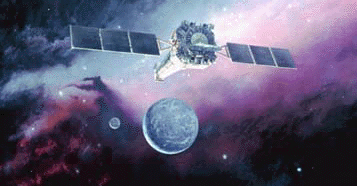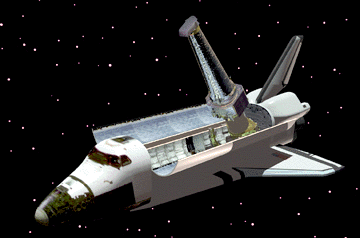Chandra Observatory Launch Lights Up the Night Sky
Chandra Observatory Launch Lights Up the Night Sky
| 23 July 1999 |
X-ray astronomy moved into the 21st century today with the launch of the Chandra X-ray Observatory (CXO). Shortly before 12:30 a.m. EDT, the Space Shuttle Columbia blasted off from the Kennedy Space Center in Florida. Under the command of Lt. Colonel Eileen Collins, the shuttle will begin to deploy CXO later today in their 5 day mission.
|
As spectacular a sight as it is to see a shuttle launch in the middle of the night, beauty is not the reason for the schedule. It all has to do with physics, primarily with a subsection called orbital mechanics. The field of orbital mechanics began long ago when Johannes Kepler discovered that planets moved in regular, elliptical paths and Isaac Newton discovered that gravity is universal. In other words, if you want to achieve a certain orbit, you have to launch at a certain time!
One of the driving considerations for selecting the CXO orbit was the lifetime of the orbit. The same forces that make the Earth's tides rise and fall will slowly change the orbit over time. NASA's baseline mission for Chandra is 5 years; the spacecraft has resources to last 10 years.
An additional factor in determining the best orbit is that Chandra has strict power requirements, so it must be oriented to expose its solar arrays properly during maneuvers to its final orbit. Furthermore, the upper stages have a horizon sensor that must look in a certain direction. These two bits of spacecraft geometry are what finally set Chandra's launch time relative to the stars, not human work schedules.
Engineers at TRW calculated the best orbit to fulfill all of Chandra's constraints. The orbit will last for about 30 years (eventually the satellite will return to Earth in a blaze of glory, burning up as it falls back into the Earth's atmosphere). The orbit will start out ranging from 10,000 to 140,000 km above the Earth (6,200 x 86,800 mi), almost a third of the way to the Moon at its the farthest distance. The orbit will be inclined 28.45 degrees to the equator, the same as the latitude of the launch site, Kennedy Space Center. Chandra's orbit has a period of 64.2 hours, with about 15 hours of that inside the Van Allen Radiation Belts, forcing operators to shut down the science instruments while the Observatory is below 24,000 mi altitude. Essential chores like repointing the Observatory and other functions that would disrupt science observations will be scheduled for the passes through the radiation belts.
How does all this lead to a launch at around midnight? Think of Chandra's final orbit as an ellipse moving with the Earth around the Sun. Even as the Earth spins, the ellipse stays pointed in the same direction. Launch and all the intermediate steps to get to the final orbit all lay within this ellipse.
The question then becomes...when does the Kennedy Space Center rotate into a proper position on the ellipse's plane so that CXO could wind up in the right place? Working through the mathematical equations, engineers determined that for a launch on July 20, 1999, the proper alignment occurred at 12:36 a.m. EDT. For every day of delay, the proper alignment for Chandra's launch moved up by 4 minutes.
Once the 50,000 kg satellite leaves the payload bay, it still has a long way to go to reach its final orbit. The boost from the shuttle orbit to Chandra's final orbit will begin when the Inertial Upper Stage (IUS) booster deploys at 7 hours, 17 minutes after launch, and its two stages will fire about an hour later. Chandra's Integral Propulsion System (IPS) will make two burns at perigee and three at apogee to raise and finalize the orbit.
 |


